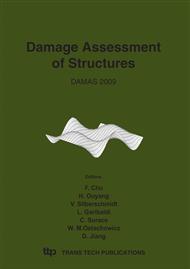p.125
p.135
p.143
p.151
p.159
p.167
p.175
p.181
p.189
Application of Hilbert-Huang Transform Method on Fault Diagnosis for Wind Turbine Rotor
Abstract:
Many signals of wind turbine faults are non-stationary and have highly complex time-frequency characteristics. Traditional time-frequency analysis method, such as Windowed Fourier Transform method, has no noticeable effect in handing non-stationary signals. Hilbert-Huang Transform (HHT) is a new signal processing method for analyzing the non-stationary mechanical signals. Based on Empirical Mode Decomposition (EMD), the Intrinsic Mode Function (IMF) in HHT can reflect the intrinsic physical characteristics of original data. Moreover, it is a good way to identify the faults involving a breakdown change. First, the principles and advantages of the HHT are presented in detail in this paper. Then, three typical faults of wind turbine rotor, such as rotor imbalance, aerodynamic asymmetry due to blade surface roughness and yaw misalignment are discussed by the HHT. Last, reasonable conclusions are drawn by the comparison between this method and the Wavelet Transform (WT) method with the help of simulation fault signals. The results show the effectiveness of HHT method for diagnosing those faults of wind turbine rotor.
Info:
Periodical:
Pages:
159-166
Citation:
Online since:
June 2009
Authors:
Keywords:
Price:
Сopyright:
© 2009 Trans Tech Publications Ltd. All Rights Reserved
Share:
Citation:


